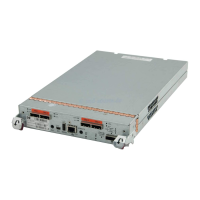74 Provisioning the system
Creating a snap pool
Before you can convert a standard volume to a master volume or create a master volume for snapshots, a
snap pool must exist. A snap pool and its associated master volumes can be in different vdisks, but must be
owned by the same controller.
To create a snap pool
1. In the Configuration View panel, right-click a vdisk and select Provisioning > Create Snap Pool.
2. In the main panel set the options:
• Snap Pool Name. Optionally change the default name for the snap pool. A snap pool name is case
sensitive and cannot already exist in the system. A name cannot include a comma, double quote, or
backslash.
• Size. Optionally change the default size, which is all free space in the vdisk.
3. Click Create Snap Pool If the task succeeds, the new snap pool appears in the Configuration View
panel.
Deleting snap pools
Before you can delete a snap pool you must delete any associated snapshots, and either delete the
associated master volume or convert the master volume to a standard volume.
To delete snap pools
1. Verify that no master volume or snapshots are associated with the snap pool.
2. In the Configuration View panel, either:
• Right-click the local system or Vdisks or a vdisk and select Provisioning > Delete Snap Pools.
• Right-click a snap pool and select Provisioning > Delete Snap Pool.
3. In the main panel, select the snap pool to delete.
4. Click Delete Snap Pool(s).
5. Click Delete to continue; otherwise, click Cancel. If you clicked Delete, a processing dialog appears.
When the snap pool is deleted it is removed from the table and from the Configuration View panel.
When processing is complete a success dialog appears.
6. Click OK.
Adding a host
To add a host
1. Determine the host's WWPN or IQN.
2. In the Configuration View panel, right-click the system or Hosts and then select Provisioning > Add Host.
3. In the main panel set the options:
• Host ID (WWN/IQN). Enter the host's WWPN or IQN. A WWPN value can include a colon
between each pair of digits but the colons will be discarded.
• Host Name. Optionally change the default name to one that helps you easily identify the host; for
example, MailServer_P1. A host name is case sensitive and cannot already exist in the system. A
name cannot include a comma, double quote, or backslash.
• Profile. Select the appropriate option that specifies whether the host allows use of LUN 0 for
mappings:
• Standard: LUN 0 can be assigned to a mapping. This is the default.
• OpenVMS: LUN 0 cannot be assigned to a mapping.
• HP-UX: LUN 0 can be assigned to a mapping and the host uses Flat Space Addressing.
4. Click Add Host. If the task succeeds, the new host appears in the Configuration View panel.
